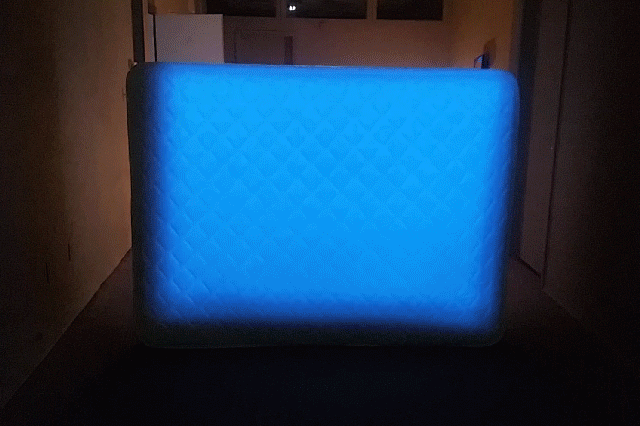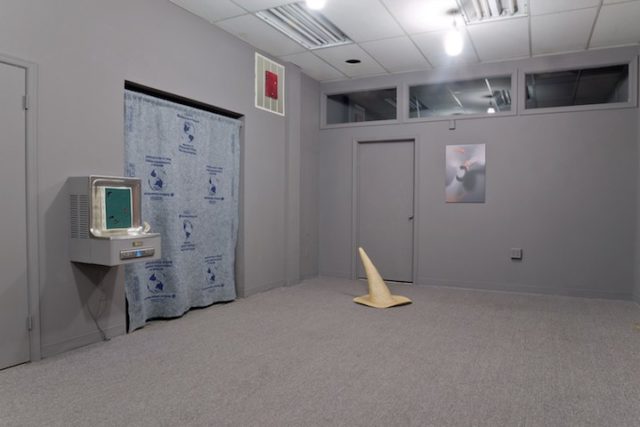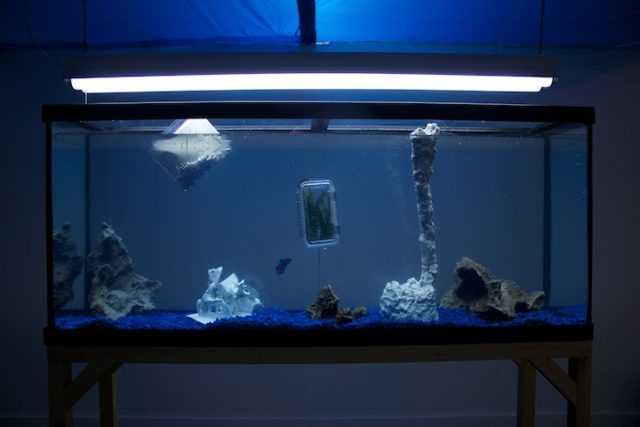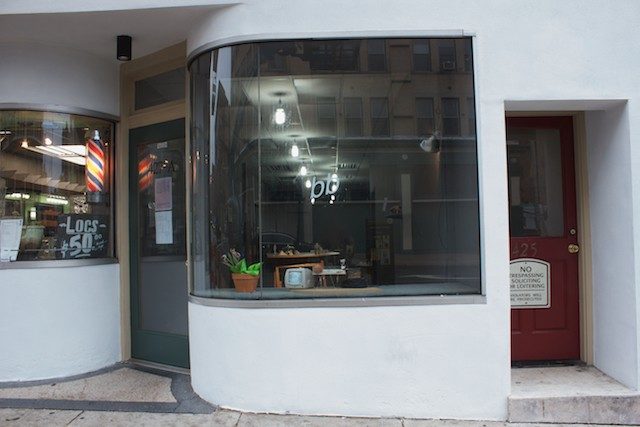
Dina Kelberman, “Roll/Roll” installed at Bb. Kelberman’s solo exhibition “No No No No No” felt like a fitting finale for the space—this piece, projected on a bare mattress, spoke to both “packing up” and a sense of provisional use of interiors, the gallery’s forte.
For the past two years, we’ve been big fans of the little artist-run space Bb, which has brought smart site-specific projects to both its odd storefront in Baltimore’s Westside and booths at art fairs. When Colin Alexander and Allie Linn, Bb’s founders, announced that the space was closing, everyone seemed to be scratching their heads. Why would a popular art space close, one year after receiving a grant and so much attention? Colin’s answer, it turns out, is pretty straightforward: “Allie and I are temporarily moving [to a small town in Connecticut] to focus on our studio practices for a while. The end of lease on the gallery space and our house happened to coincide, so it seemed like a good opportunity to archive the project and let it exist as a two year project.” The pair also assured us that they’ll likely be back to Baltimore to pursue other curatorial projects, and that their brick-and-mortar space is going to live on under a new name and management. I spoke to Allie and Colin about the challenges and triumphs of their two-year endeavor:
One of many things I’ll miss about Bb: your storefront space was so weird! I always really liked that about it—as this all-grey office building interior in a little retail space it totally stood out from all the other white box storefronts or lofts around the neighborhood. How did you come across that location/chose it?
Colin: At the time we were searching for studio space with 5 other artists. A lot of the storefronts in the area go vacant for a long time, so this was one that was being used by political campaigns every now and then for brief periods. It housed the business of a tailor named Shimba Inc. before that. Realizing that a drop tile, office-space style structure could work more affordably than warehouse space was sort of wild considering Baltimore’s industrial history, but it has the obvious benefit of store front accessibility. It was sort of a chance find.
Ha! It’s so funny that now crappy industrial buildings are all snatched-up for luxury developments, retail, coworking office space, etc… and all these existing, purpose-built retail and office spaces are sitting empty… the fickle tastes of the mainstream never cease to amaze me.
Colin: I know! It worked out for us—the aspect of warehouse living assimilating into interior design aesthetics is just something to be extra aware of…

“A Temporary Curse,” installation view, 2016. Image courtesy of Bb.
I feel like I often didn’t catch a lot of the programming you put on in the brick-and-mortar space, but your contributions to fairs were always the most memorable and site-specific booths. I’m thinking of your fish tank installation at the Artist-Run fair in Baltimore and the Artist-Run Satellite Show in Miami Beach. You have such a proclivity for really smart approaches to creative installs in new spaces. Could you talk about that, and what a nomadic curatorial practice might look like in the future?
Allie: Thanks Michael! A lot of the thinking that went into organizing booths for both of those fairs stemmed from working inside of Bb’s brick-and-mortar space—an all-grey space with a matching carpet and drop ceiling that doesn’t necessarily provide a neutral backdrop to its exhibitions. From the beginning, it was evident that we had to be very mindful of how we were using the space. We’ve had a lot of fun organizing group exhibitions and creating some rules for the artists; for the show Slsleeping at the Artist-Run Art Fair in 2015, we presented four artists we both really admire with the problem of making work that could exist underwater; in Miami, for Brass in Pocket, Third Chorus, we were trying to make extremely subtle alterations to the hotel room which elicited a very different kind of work. I think we both really enjoy finding a space and organizing the objects inside to make some kind of cohesive conversation, which lends itself to existing more nomadically in the future. There are a few projects we were hoping to do in Baltimore before moving that haven’t yet panned out, but hopefully will in the future.
Colin: As far as the possibility of what a future nomadic practice might look like, I think because our interest is as much in mindfully pairing artist’s practices with each other as it is with pairing those practices with spaces and contexts, it’s something that could happen without too much adjustment—and that might be why it’s worked out well in the past
Allie: One thing that is easier for me to see now that the project is drawing to a close is that Bb was very interested in the navigation of the viewer inside of a designated art space. The fish swimming around the aquarium and using the sculptures inside of it created a really interesting surrogate for the viewer to experience the works. And in Miami, the room was something like a scavenger hunt or haunted house that provided a lot of opportunities for stumbling upon easy to miss work (a laser-cut work by Max Guy hung on an adjacent building, visible through the window; a painting by Audrey Gair hung inside of a shower curtain, visible through a peephole in the wall; custom-made hardware by Alex Goss that replaced all of the screws in the hotel room).

Bb’s group show “Slsleeping” was installed in a fish tank at The Artist-Run Art Fair in Baltimore, 2015.
What are some of those dream exhibitions that never came to fruition in Baltimore?
Colin: We were talking about this the other day with a couple of ideas that are total reaches with the current structures, we’re both really interested in the practices of Hito Steyerl and Marlo Pascual.
In Baltimore, we had started doing some work to organize a show at the Rawlings Conservatory in Druid Hill Park that unfortunately couldn’t happen under the timeline. There’s been at least one music performance that happened there but it has a lot of potential for installing work. It’s the second oldest glass botanic conservatory in the U.S. and the shifts in its architecture are really incredible as it goes from Mediterranean to Desert to Tropical, etc. This is a project we’re hoping to return to in time once we can accommodate the sort of advance scheduling they require.
Could you talk about the $4,400 Grit Fund grant you received from The Contemporary last year? What does a grant like that mean for an artist-run space? What types of programming were you able to do that otherwise wouldn’t have happened, etc..?
Allie: We received a Grit Fund shortly after opening in April 2015 alongside nine other Baltimore-based galleries, collectives, and projects, including Exittheapple, It’s My Skate Night, and Sight Unseen. The funding essentially allowed us to carry out programming for the next year and a half, including a small lecture series, a live Talk Show (which had two full episodes), a performance and sound event (Femmewrath), and various on-going programming in addition to exhibitions.
It has proven to be an incredible grant for similarly-sized projects that are collaborative but don’t fall under the category of a 501(c)(3) non-profit. It is so important to not worry about the financial sustainability of a gallery or project space in order to focus on the work happening inside.
Colin: Right, the aspect of it being specifically for non-501(c)(3) projects is kind of amazing because it opens up the board for a lot of projects that rarely have a seat at the table. Aside from that, even though it’s semi-impossible to sustain a gallery in Baltimore on art sales, we were able to do a lot of projects without the pressure to fit within a market niche or to go into debt over these projects.
Allie: We were then able to also pay a lot of local artists; so much work here is done for free, which is admirable and inspiring, but it felt significant to be able to pay everyone who lectured in the space and documented the exhibitions. The Grit Fund enabled us to provide free drawing materials and food for our biweekly Drawing Nights and subsidize travel and shipment for work that would have ordinarily been out of our budget. I can’t stress enough how important of a grant it was for us. Running a space can be a huge financial burden, even in Baltimore.

Image courtesy of Bb.
What are some of the things you’ve learned from running the space?
Colin: Operating with so many different types of events revealed just how much energy you have to invest for seemingly simple programming to go really well. On the other side of that, we had two break-ins in May that sucked up a lot of time time dealing with insurance, trying to reimburse our studio tenants (which included both of us) for stolen tools, damaged art, damaged property, etc. That quickly showed how you have to take advantage of the time you have when everything is actually going right.
Allie: Despite all of the repercussions of the break-ins, it has been something of a utopia to be able to organize the projects we want to have happen and not have to respond to anyone else to bring them to fruition. It’s a very different experience to run a space independently as compared to working in a larger gallery/museum institution.
So are you going to contribute to our defunct artist-run spaces zine?
Allie: Yup, we definitely can! There have been so many moments throughout Bb’s history where I remember that the best thing a space can provide is just that: space. Space for talking, space for gathering. Our inaugural exhibition/event, Hello World; the sign-making workshop for the protests following the death of Freddie Gray; the performances during Femmewrath. It’s most special to see the small, narrow space filled with both friends and strangers who happened to walk by and peek through the window.


Comments on this entry are closed.